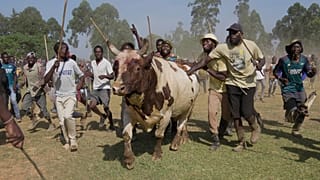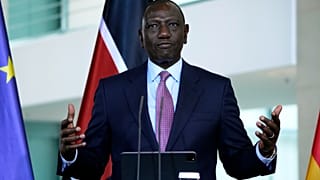Kenya
The beat of the atabaque drum echoes through the streets of Kibera. It's accompanied by the twang of the berimbau and is the soundtrack to this rhythmic dance display. Here in one of Africa's largest slums, on the outskirts of Kenyan capital Nairobi, capoeira is taking root. The Afro-Brazilian martial art that blends elements of dance, music, acrobatics and combat. Inside the circle, two bodies sway, dodge and leap with power and grace.
The mestre leads with songs, others echo in vibrant chants and melodies. "The roots of capoeira come from Angola and Congo and it was established by the enslaved Africans who were brought from that region of central west Africa to Brazil," explains Salim Rollins, the founder of Capoeira Angola Centre in Kibera. "It was a form of resistance of using martial forms that are from Africa as a form of resistance to the institution of slavery and the oppression that these different ethnic groups experienced." Rollins, popularly known by his students as Mestre Salim, founded Capoeira Angola Centre in this area of Nairobi where he trains local children and adults.
Nasri Babu, a 25-year-old capoeirista, started learning in 2019. He says it's a good way to manage the stresses in his life. "From the community I come from, there is a lot going on and capoeira has always played a big part like a therapy thing, it has always been like a therapy to me," he says. In the late 19th and early 20th centuries, Brazilian authorities outlawed capoeira as it became associated with vagrancy and street gangs. In the 1930s, capoeira was developed into a structured system, called Capoeira Regional, which incorporated traditional movements with new techniques and emphasized self-defence, helping to legitimize Capoeira as a respected martial art.
“It has also helped me with self awareness, self discipline and it has also helped with self defence," says Beckham Otieno, an 18-year-old capoeirista. "When somebody attacks me, I know how to use the capoeira moves. I can't be damaged because capoeira helps me with those skills and I apply them in the streets,” In 2014, UNESCO declared Capoeira Circle an Intangible Cultural Heritage of Humanity, acknowledging its significance as a symbol of resistance, identity, cultural expression and unity.
"There's also a ritual element that's really important within capoeira," adds Rollins. "You see, we practice in a circle, and you see there's call-and-response songs. So, that's the idea of creating an energy within that circle and also sort of feeding and contributing to the two practitioners." Movement and discipline, being embraced by a new generation of Kenyans.











00:59
IOC seeks to reintegrate Russia, Belarus into world sports despite ongoing war
01:41
Eritrean Biniam Girmay hired as lead cyclist for former Israeli team
01:03
Kenyan parliament report condemns British army unit BATUK over decades of abuses
01:03
Caribbean delegation seeks justice for slavery in Britain
01:13
Hundreds of voodoo worshipers mark Day of the Dead in Haiti
00:46
Final preparations underway with 100 days to Winter Olympics in Milano-Cortina